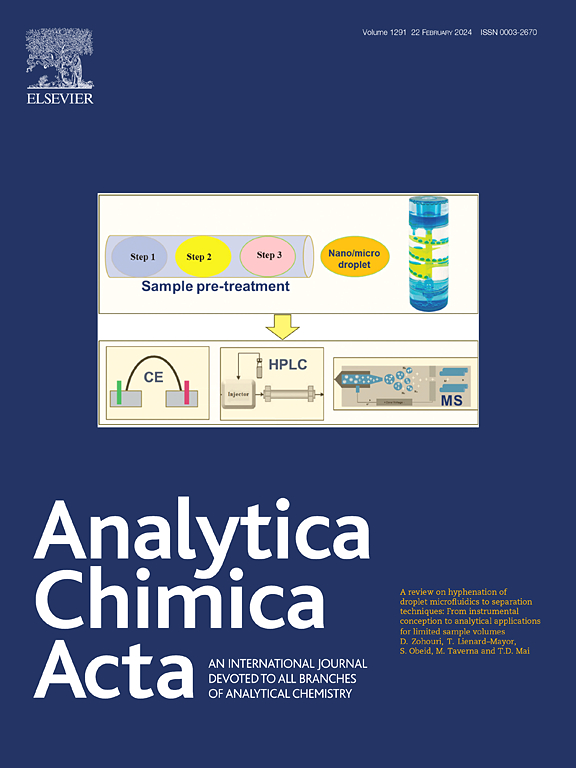基于TMB-Au@PB纳米颗粒表面增强拉曼光谱技术的h2o2相关生物标志物定量分析
IF 5.7
2区 化学
Q1 CHEMISTRY, ANALYTICAL
引用次数: 0
摘要
过氧化氢(H2O2)是活性氧的关键组成部分,与生物体内许多病理和生理过程错综复杂地交织在一起。在疾病诊断领域,精确检测H2O2及其相关生物标志物在识别疾病状态中起着至关重要的作用,是至关重要的。然而,目前的方法往往存在灵敏度和可靠性有限的问题。迫切需要一种可靠的、高度准确的方法来检测这些物质,旨在提高诊断精度并实现疾病的早期干预。结果在金纳米粒子(Au@PB NPs)表面涂覆普鲁士蓝(PB)制备了一种新型表面增强拉曼散射(SERS)底物,用于检测H2O2和丙氨酸转氨酶(ALT)、胆固醇、尿酸等生物标志物。PB拉曼信号是一种理想的、无干扰的内标,用于校正分析物的拉曼强度波动,实现准确的定量。Au@PB NPs作为一种过氧化物酶模拟酶,在H2O2存在下催化3,3',5,5'-四甲基联苯胺(TMB)的氧化。该方法对H2O2的检出限为0.19×10-12 M,线性范围为10 ~ 12 ~ 10 ~ 2 M,对ALT、胆固醇和尿酸的线性范围分别为0.5 ~ 100 U/L、10 ~ 500 μM和5 ~ 600 μM。通过干扰和交叉反应实验评估特异性。结果表明,干扰可忽略不计,拉曼信号稳定,相对误差小于3%。临床血清样品验证结果一致性高,一致性范围在92.49% ~ 105.92%之间,平均误差小于5%,证明了方法的精密度和可靠性。本研究提出了一种高度灵敏、准确的检测H2O2及关键生物标志物的方法,为肝肾损害的早期诊断提供了重要的潜力。该方法为临床应用提供了一个强大的工具,能够精确监测疾病相关的生化变化。本文章由计算机程序翻译,如有差异,请以英文原文为准。

Quantitative analysis of H2O2-related biomarkers using surface-enhanced Raman spectroscopy technology based on TMB-Au@PB nanoparticles
Background
Hydrogen peroxide (H2O2), a pivotal component of reactive oxygen species, is intricately intertwined with numerous pathological and physiological processes within organisms. In the disease diagnosis domain, the precise detection of H2O2 and its associated biomarkers, which play crucial roles in discerning disease states, is of paramount importance. However, current methods often suffer from limited sensitivity and reliability. There is an urgent need for a reliable, highly accurate method to detect these substances, aiming to enhance diagnostic precision and enable early disease intervention.
Results
A novel Surface Enhanced Raman Scattering (SERS) substrate was developed by coating Prussian blue (PB) on gold nanoparticles (Au@PB NPs) for the detection of H2O2 and biomarkers such as alanine aminotransferase (ALT), cholesterol, and uric acid. The PB Raman signal serves as an ideal and non-interfering internal standard to correct the Raman intensity fluctuations of analytes for accurate quantification. The Au@PB NPs acted as a peroxidase-mimicking enzyme, catalyzing the oxidation of 3,3′,5,5′-tetramethylbenzidine (TMB) in the presence of H2O2. The method achieved a detection limit of 0.19 × 10−12 M for H2O2, with a linear range of 10−12 to 10−2 M. Linear detection ranges for ALT, cholesterol and uric acid were 0.5–100 U/L, 10–500 μM, and 5–600 μM, respectively. The specificity was assessed through interference and cross-reactivity experiments. The results showed negligible interference, stable Raman signals, and a relative error of less than 3 %. Clinical serum samples validation exhibited a high degree of consistency, ranging from 92.49 % to 105.92 %, with an average discrepancy of less than 5 %, demonstrating the method's precision and reliability.
Significance
This study presents a highly sensitive and accurate method for detecting H2O2 and key biomarkers, offering significant potential for early diagnosis of liver and kidney damage. The approach provides a robust tool for clinical applications, enabling precise monitoring of disease-related biochemical alterations.
求助全文
通过发布文献求助,成功后即可免费获取论文全文。
去求助
来源期刊

Analytica Chimica Acta
化学-分析化学
CiteScore
10.40
自引率
6.50%
发文量
1081
审稿时长
38 days
期刊介绍:
Analytica Chimica Acta has an open access mirror journal Analytica Chimica Acta: X, sharing the same aims and scope, editorial team, submission system and rigorous peer review.
Analytica Chimica Acta provides a forum for the rapid publication of original research, and critical, comprehensive reviews dealing with all aspects of fundamental and applied modern analytical chemistry. The journal welcomes the submission of research papers which report studies concerning the development of new and significant analytical methodologies. In determining the suitability of submitted articles for publication, particular scrutiny will be placed on the degree of novelty and impact of the research and the extent to which it adds to the existing body of knowledge in analytical chemistry.
 求助内容:
求助内容: 应助结果提醒方式:
应助结果提醒方式:


